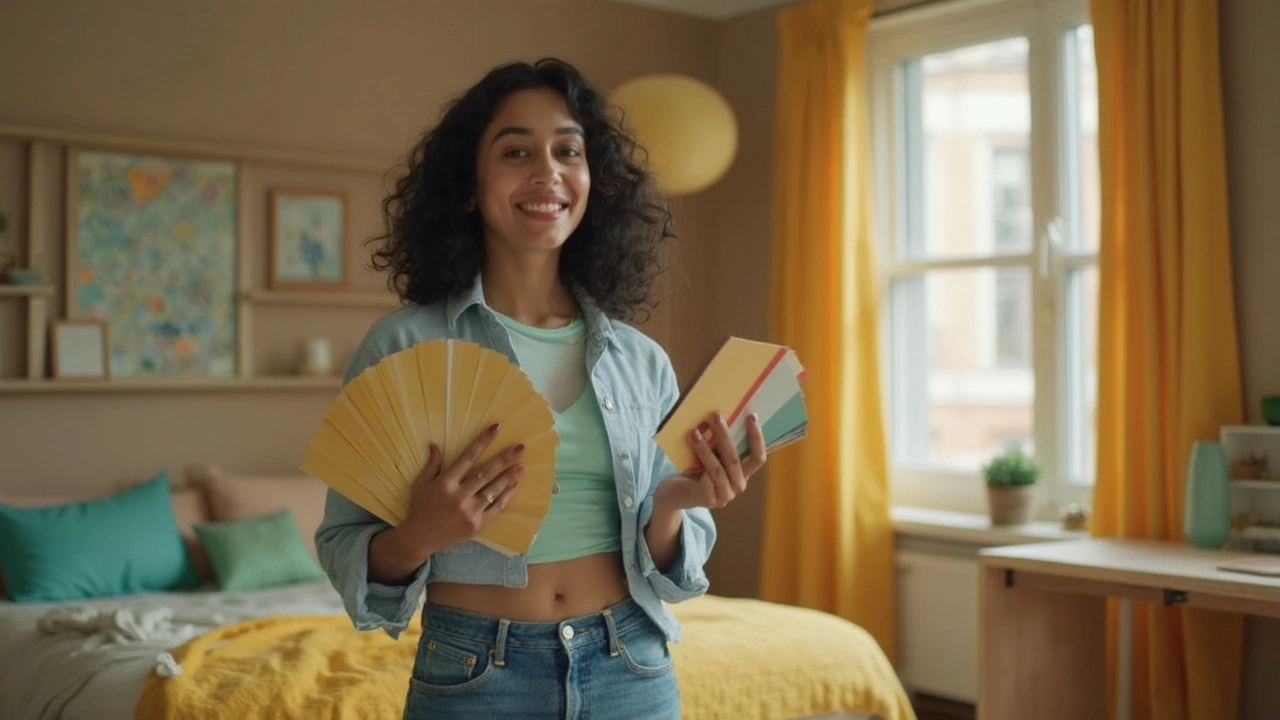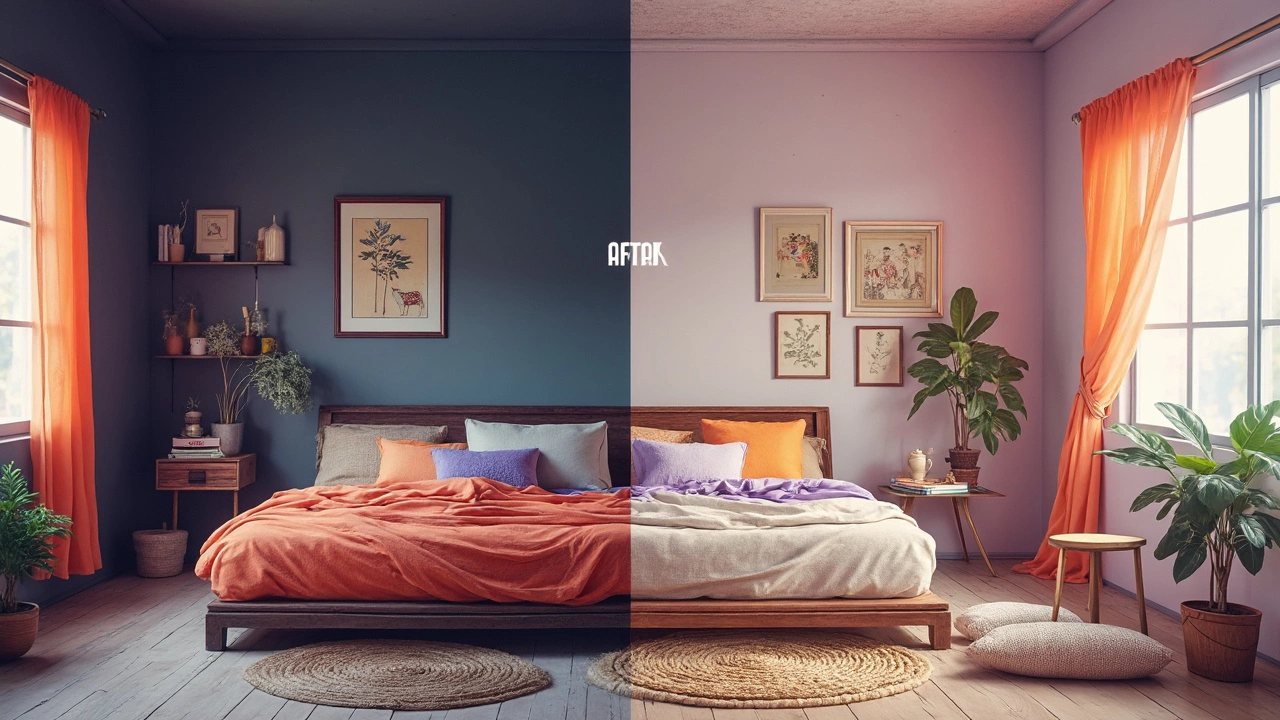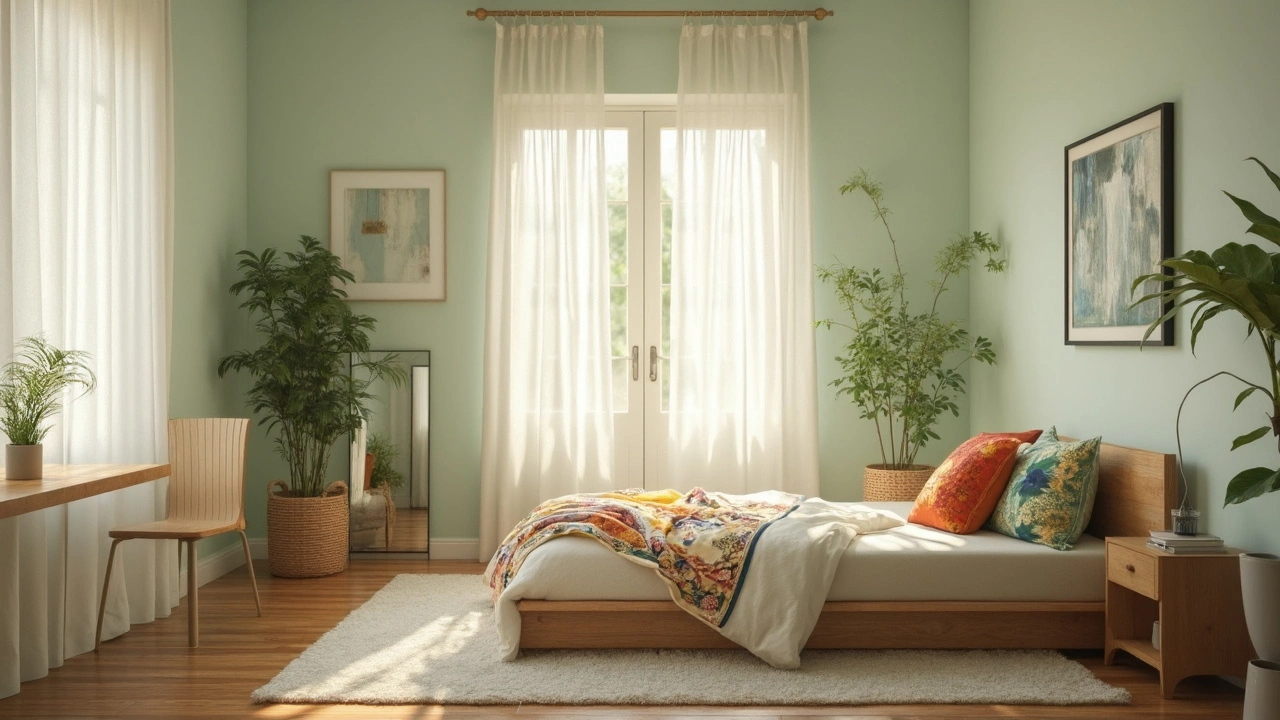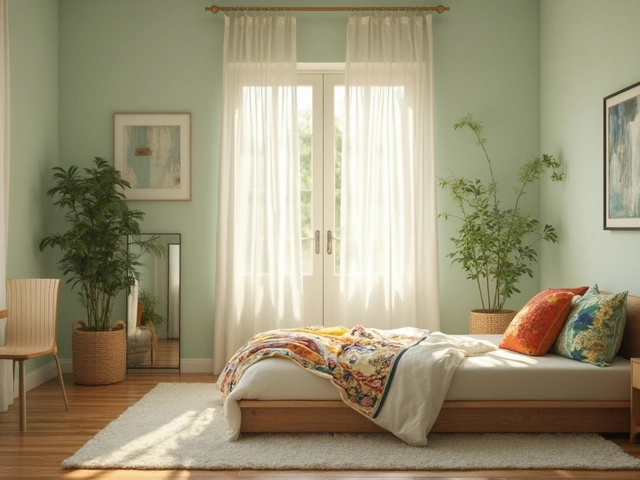If your bedroom feels tight, the color on your walls might be half the problem. You’d be amazed what a can of paint can do. Light colors like white, soft grey, or pale blue bounce light around, making even tiny rooms look way more open. Ever wondered why rental apartments are almost always painted off-white? It’s a trick to stretch the space visually—no magic, just color science at work.
But hold up, color isn’t just about the walls. The ceiling, trim, and even your bedding can play a part in how big the room looks. Most folks stick to plain white thinking it’s the only solution. That’s not true. Pick the right tone, blend it with your bedroom light, and suddenly that poky spare room feels like a place you want to hang out.
- Why Color Changes the Feel of Your Room
- Best Light Colors for a Bigger Look
- Using Bold Colors Without Shrinking the Space
- Ceiling Tricks and Accent Wall Ideas
- Common Mistakes and Quick Fixes
Why Color Changes the Feel of Your Room
Ever walked into a room and felt it was bigger or smaller than it actually is? That’s your eyes playing tricks on you, and color is the main culprit. Lighter paint reflects more natural and artificial light, so spaces look brighter and open, not cramped. Dark colors soak up light, causing the walls to close in and make everything feel a bit tighter. The science behind this is simple: more reflected light = more visual space.
Real estate pros use this trick all the time. They’ll slap on a coat of pale paint before selling a house to make rooms look airy and inviting. It’s not just about the color itself—it’s about how that color reacts to your lighting, your furniture, and even the time of day.
There’s also the vibe certain colors create. Soft blues and greens can feel calming, turning your bedroom into a chill zone. Meanwhile, warm whites and beiges make a room look welcoming, not cold. Even a barely-there pink can add warmth without making things feel smaller.
The real key here: if you want your room colors to help make things look bigger, you need to pay attention to reflectivity. High-gloss or eggshell finishes bounce more light than matte ones, inching your space closer to that open, fresh look.
Bottom line: color isn’t just decoration—it messes with how big your room feels. And if you use it smartly, you can make a small bedroom feel huge without moving a single wall.
Best Light Colors for a Bigger Look
Light colors reflect more natural and man-made light, so they make small rooms feel open instead of cramped. If you're battling with a bedroom that feels boxy or tight, color is the fastest fix that doesn’t involve major renovations.
Here’s a simple truth: White isn’t your only friend. While classic white works wonders, designers recommend checking out off-whites, pale greys, creamy ivories, and light blues. Why? Because these shades don’t just bounce light back—they also add warmth or coolness to match your vibe.
"Pale neutrals like soft grays or gentle taupes make your walls recede visually, which tricks your eye into thinking there’s more space than there really is." – Emily Henderson, award-winning interior designer
People love white for good reason—it’s safe and clean. But let’s get real: too much pure white can look sterile, almost hospital-like. To dodge that cold feeling, try these popular options:
- Sherwin-Williams ‘Alabaster’ – a creamy white that’s never stark.
- Benjamin Moore ‘Gray Owl’ – a light gray that looks awesome in both natural and artificial light.
- Behr ‘Soft Mint’ – adds a whisper of color without shrinking your space.
- Valspar ‘Ocean Storm’ – a pale blue that makes any room feel fresher.
- Dunn-Edwards ‘Whisper’ – super subtle, blends with pretty much anything.
If you’re worried your bedroom doesn’t get much sunlight, stick to warmer tones like creamy off-whites or hints of honey beige. They stop a room from feeling icy when there’s not much brightness coming in.
For folks who like some hard numbers, check out this little reference table for popular shades and their "Light Reflectance Value" (LRV). The higher the number, the more light that color bounces around—key when you want to make room look bigger.
| Paint Color | LRV (Light Reflectance Value) |
|---|---|
| Sherwin-Williams Alabaster | 82 |
| Benjamin Moore Gray Owl | 65 |
| Behr Soft Mint | 78 |
| Valspar Ocean Storm | 74 |
| Dunn-Edwards Whisper | 87 |
The takeaway? Go for paint with a LRV above 70 whenever possible. It instantly helps bounce light, removes shadow pockets, and makes everything feel spacious—even if you’re maxed out on square footage.

Using Bold Colors Without Shrinking the Space
People always think you have to avoid strong colors in a small bedroom. That’s not true. You can use bold shades without making your room feel cramped. The trick is all about placement and balance. Paint one wall in a bold color and keep the others light. This creates a focal point and the light walls push the background further, making the space feel deeper—not smaller.
Some shades actually help the room pop. Deep blue, rich green, or even moody charcoal can work if used the right way. If you want to try a darker color but still keep things open, stick to one accent wall or even just the lower half of your wall using a chair rail. Whenever I painted a small space for friends, going half-and-half was a game changer. Try pairing with crisp white trim for even more contrast.
Bolder colors suit rooms with good natural light best. If your bedroom's got a decent window, you’ve got more freedom to play. But if it’s a cave, keep the ceiling and any trim light—this helps reflect whatever light you get.
- Stick to bold shades on one wall or in strategic spots
- Keep the other walls, ceiling, and trim room colors light
- Mix bold paint with light bedding and simple, uncluttered decor
- Gloss or satin paint on trim can bounce light and give a cleaner edge
If you want a quick fact: a 2023 survey by a popular US paint brand found that rooms with an accent wall painted in navy or forest green were picked as 'more inviting and airier' by over 60% of people, compared to rooms painted in all-over dark colors.
| Bold Color | Best Spot for Use | Best Paired With |
|---|---|---|
| Navy Blue | Accent wall behind bed | White or pale gray walls |
| Emerald Green | Lower half of wall | Light beige upper wall, white trim |
| Charcoal | Window wall | Soft pastel bedding, white ceiling |
The bottom line: bold colors aren’t the enemy. Use them smart and your small bedroom will feel bigger, not boxed in.
Ceiling Tricks and Accent Wall Ideas
People often forget the ceiling, but changing its color can really change how big your bedroom feels. If your ceiling matches your wall paint—especially in a light shade—the line where the wall ends blurs just a bit. That little blur fools your eye and makes the whole place look taller. This is why designers use the same pale colors for small bedrooms top to bottom.
Another decent trick? Paint the ceiling just a shade lighter than your walls. It adds some difference but keeps the visual flow going strong. If you want to get creative, add a barely-there pastel on your ceiling—think soft blue or the lightest beige. Just keep it lighter than the walls. Dark or bright ceilings make rooms feel shorter, unless the whole room is drenched in the same color, in which case the boundaries melt and the space still feels open.
Now, accent walls can totally work in a bedroom decor plan, but you have to play it cool with the color. Stick to just one wall—the one behind the bed is most common. Use a bolder shade or deeper tone, but pick something that blends well with the light walls around it, like navy with crisp white, or charcoal with a silvery grey. This draws attention and adds depth, but doesn’t close the space in.
- To stretch a room up, paint vertical stripes (thin ones, nothing wild) on the accent wall or ceiling. Stripes add height.
- If you want width, horizontal stripes do the job, but keep them subtle and not too wide.
- Skip super dark paints for accent walls in tiny spaces—they’re best for rooms that get tons of sun. In low light, they squeeze space even more.
If you’re dealing with old, bumpy ceilings, a flat paint finish can help hide the flaws. And leave crown molding the same color as the ceiling—don’t break up lines if you want more openness.

Common Mistakes and Quick Fixes
People often grab a bold paint can thinking it’ll add character to a small bedroom, but oversized patterns or dramatic dark shades usually make things feel tighter. One major trap is picking colors in the store under buzzing fluorescent lights. At home, with your regular lamps or daylight, the color can look way off—and suddenly your cozy nook feels more like a closet.
You’ve probably seen rooms with every wall painted a different color. While it sounds fun, it actually chops up the space visually. Too many accent walls or busy wallpapers also shrink the room. And a common myth: using all white everywhere will automatically make a room feel huge. If you use bright white with no warm undertones, things can feel cold and kinda stark—almost clinical instead of inviting.
Here are classic mistakes and some quick fixes that work:
- Picking the wrong undertones: Warm whites and gentle grays feel bigger and cozier than blue-toned whites.
- Ignoring the ceiling: Paint it a shade lighter than your walls to give a taller, airy feel.
- Heavy, dark curtains: Swap them for light, sheer fabrics to let more daylight in.
- Clutter on walls and shelves: The more stuff everywhere, the smaller it looks. Tidy up and keep decor minimal.
- Matching everything: Don’t just stick to one color. Layer different light, neutral shades for depth.
Want a fast hack? Pick a mirror that’s as big as you can fit, and hang it across from a window. This bounces natural light around, stretching the whole room visually. For stats buffs, check out the table below—it shows how people rate the look of their bedroom after trying some of these quick fixes.
| Fix Tried | Reported Space Improvement | Satisfaction (%) |
|---|---|---|
| Switched to warm, light paint | Room felt larger | 88 |
| Hung a big mirror | Brighter and more open | 84 |
| Decluttered walls | Less cramped feeling | 76 |
| Changed to sheer curtains | More sunlight, airier | 80 |
| Painted ceiling lighter | Taller appearance | 71 |
Try one or even a combo for your bedroom decor. With a few hours’ work, you can fake a little extra square footage and be happier with your space.

